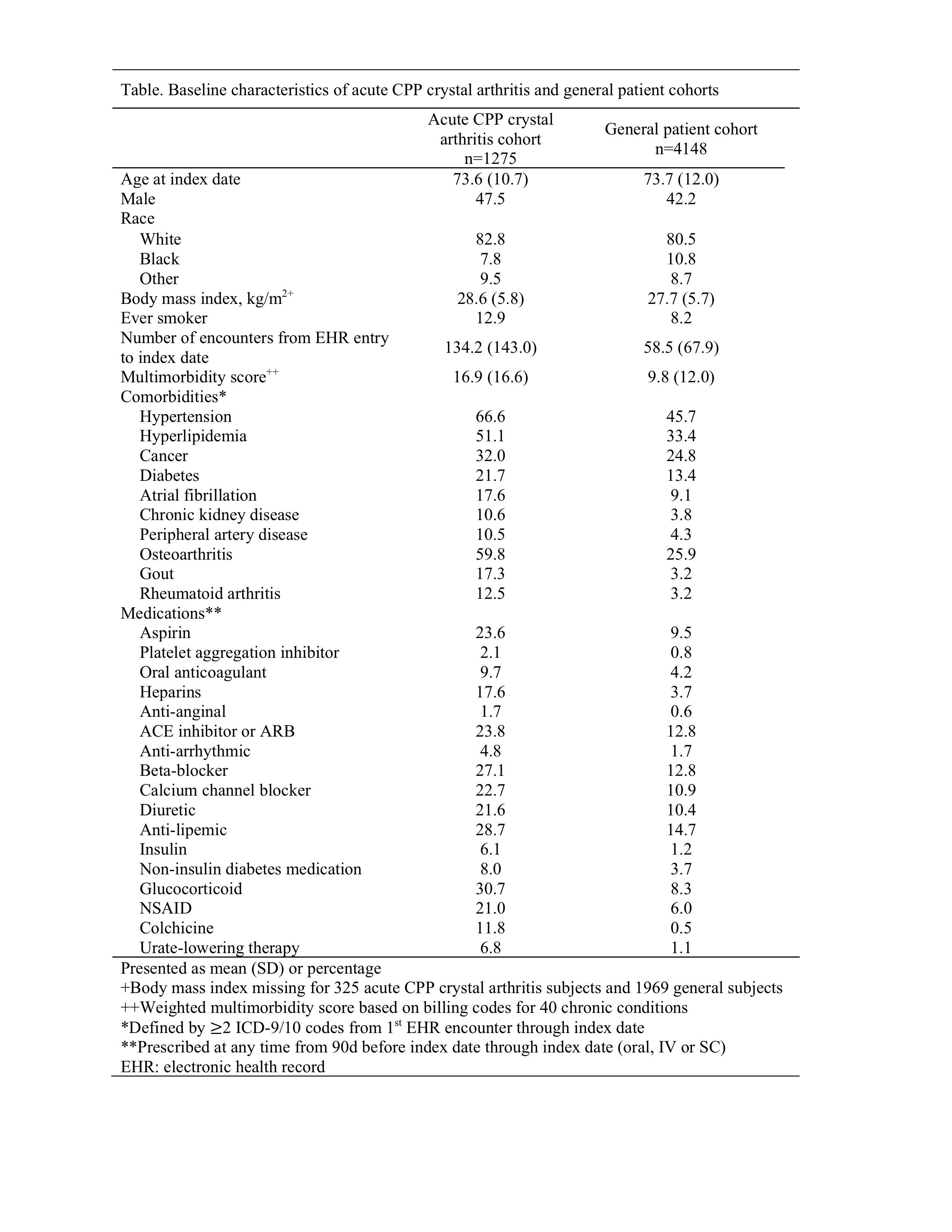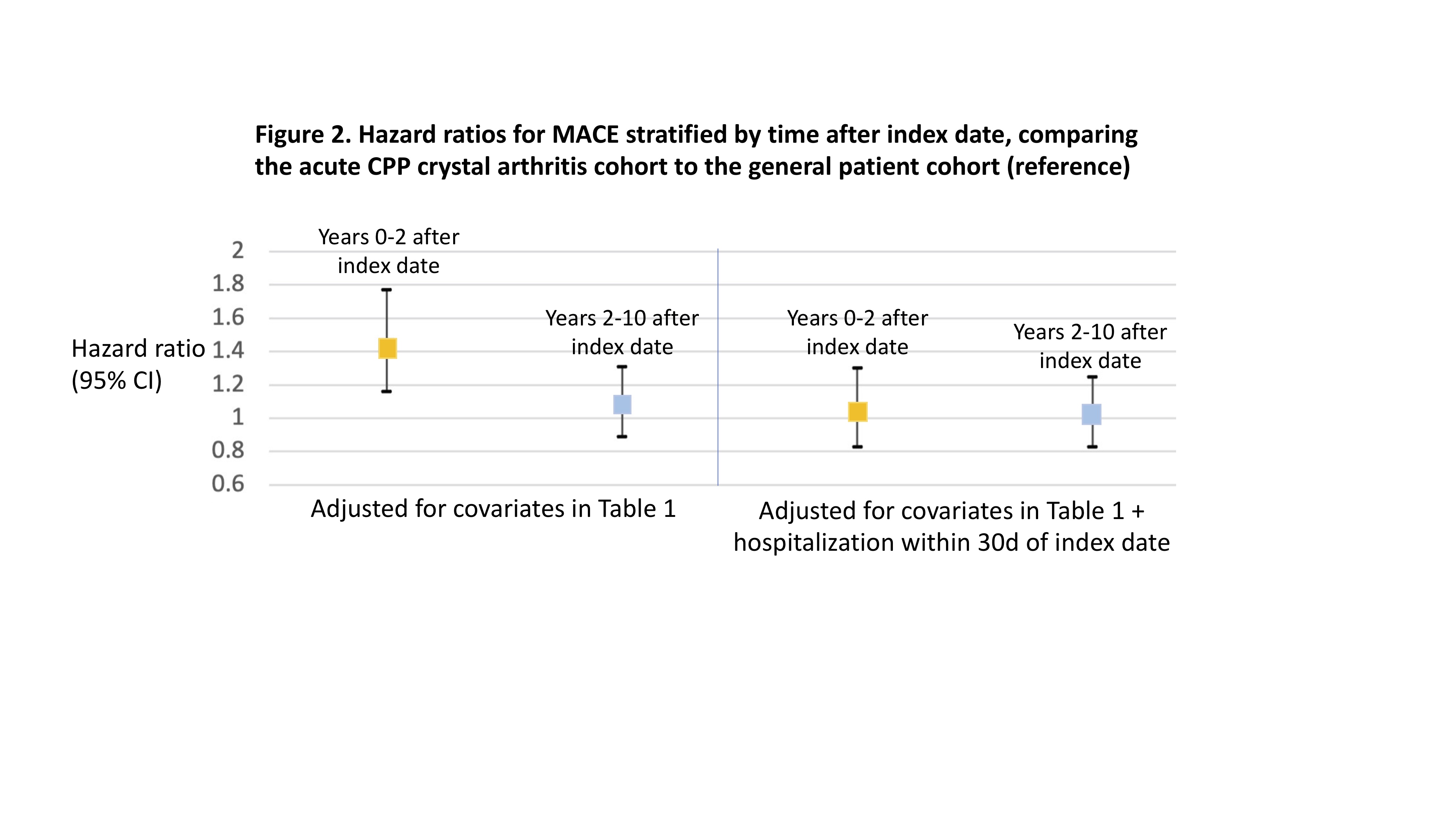Session Information
Date: Tuesday, November 9, 2021
Title: Abstracts: Metabolic & Crystal Arthropathies – Basic & Clinical Science (1897–1900)
Session Type: Abstract Session
Session Time: 10:45AM-11:00AM
Background/Purpose: Acute calcium pyrophosphate (CPP) crystal arthritis, also known as pseudogout, causes an acute inflammatory arthritis that shares clinical similarities with gout. We investigated the risk of incident cardiovascular events in patients with acute CPP crystal arthritis.
Methods: We performed a matched cohort study using electronic health record (EHR) data at an academic medical center, 1990-2017. Major adverse cardiovascular event (MACE), defined as myocardial infarction, re-vascularization, stroke or death, was identified using inpatient diagnosis codes, inpatient/outpatient procedure codes, and vital status. We applied an EHR-based algorithm with a positive predictive value of 81% for acute CPP crystal arthritis to identify the exposed cohort, which we matched to an unexposed general patient cohort on year of EHR entry and index date. Follow-up began at index date (1st mention of “pseudogout” in notes or 1st positive synovial fluid CPP crystal result, or a matched encounter date for the general patient cohort) and ended at MACE or the last encounter before/at 10 years of follow-up. We required age ≥50, ≥180d enrollment before index date and ≥2 encounters during that window for both cohorts. Subjects with MACE occurring from 1st EHR encounter through index date were excluded. Incidence rates (IR) and IR ratios (IRR) were estimated. A Kaplan-Meier curve and log-rank test compared MACE-free survival between the cohorts. Cox proportional hazards models estimated risk of MACE, adjusting for baseline traditional cardiovascular risk factors and healthcare utilization, and allowed for differential effects of acute CPP crystal arthritis over time.
Results: The acute CPP crystal arthritis cohort included 1,275 patients (mean age 72.9 years, 54.4% female) that were matched to 4,148 general patients (mean age 72.9 years, 59.0% female) with 23,144 total person-years follow-up. Cardiovascular comorbidities including hypertension, hyperlipidemia, and diabetes were more common in the acute CPP crystal arthritis cohort, as were prescriptions for NSAIDs and glucocorticoids (Table). MACE IR was highest in the first year after index date in each cohort: 10.1 per 100 person-years in the acute CPP crystal arthritis cohort and 6.2 per 100 person-years in the general cohort (IRR 1.64, 95% CI 1.31, 2.05). Acute CPP crystal arthritis was associated with significantly greater risk for MACE compared to the general cohort in the first two years after index date (HR 1.43, 95% CI 1.16, 1.77), but not in later years (Figures). Additional adjustment for hospitalization within 30 days of index date attenuated the HR during the first two years after index date (HR 1.04, 95% CI 0.83, 1.30).
Conclusion: Patients with acute CPP crystal arthritis were at increased risk for MACE in the first two years after index date, but not in subsequent years. Diagnosis of this acute, episodic crystalline arthritis in the inpatient setting confounds this association and partially explains the observed increased risk.
To cite this abstract in AMA style:
Tedeschi S, Huang W, Yoshida K, Solomon D. Risk of Major Adverse Cardiovascular Events in a Large Cohort of Patients with Acute Calcium Pyrophosphate Crystal Arthritis [abstract]. Arthritis Rheumatol. 2021; 73 (suppl 9). https://acrabstracts.org/abstract/risk-of-major-adverse-cardiovascular-events-in-a-large-cohort-of-patients-with-acute-calcium-pyrophosphate-crystal-arthritis/. Accessed .« Back to ACR Convergence 2021
ACR Meeting Abstracts - https://acrabstracts.org/abstract/risk-of-major-adverse-cardiovascular-events-in-a-large-cohort-of-patients-with-acute-calcium-pyrophosphate-crystal-arthritis/



